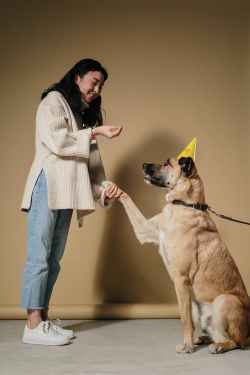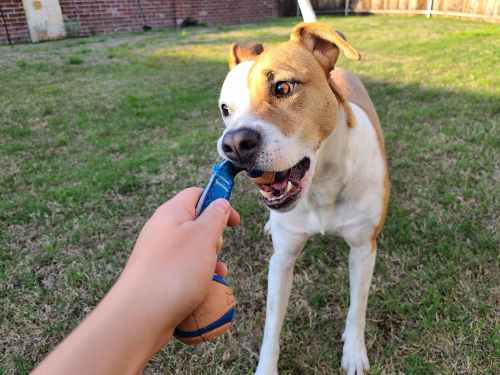Owning a dog is a beautiful experience full of love, loyalty, and companionship. However, an integral part of this experience is teaching your furry friend how to behave properly. The concept of dog discipline is not about punishment, but rather about teaching your pet appropriate behavior. This article will provide a comprehensive guide on how to discipline a dog effectively.
Understanding Dog Behavior
Canine Communication
Understanding how dogs communicate is a fundamental part of effective discipline. Dogs communicate their feelings using a combination of body language, sounds, and facial expressions. It’s essential to pay attention to these signs when interacting with your dog, especially during disciplinary moments.
For instance, if a dog’s tail is wagging, it doesn’t necessarily mean they’re happy. The tail’s position and speed can indicate a range of emotions from excitement to fear. Ears pinned back, exposing the whites of their eyes, or low body posture could indicate anxiety or fear.
Similarly, barking, growling, or whining could communicate different needs or emotions. Growling may be seen as aggressive behavior, but it’s also a dog’s way of setting boundaries. It’s crucial to interpret these signals correctly to respond appropriately and effectively.
Positive Reinforcement
Positive reinforcement is a fundamental aspect of effective dog discipline. The concept of this approach is straightforward and based on rewarding good behavior, thereby encouraging its repetition, rather than punishing bad behavior.
Rewards come in various forms, such as treats, praise, or playtime, depending on what motivates your dog the most. For example, if your dog sits when commanded, immediately give them a treat or a pat on the head. This immediate, positive response helps your dog associate sitting on command with a positive outcome, making them more likely to repeat the behavior.
Basic Dog Training Techniques
The Use of Voice Commands
Voice commands are a powerful tool in the dog discipline toolkit. These commands should be short, usually one or two words, clear, and most importantly, consistent. Consistency is vital to avoid confusing your dog; use the same words each time to mean the same thing. Common commands include “sit,” “stay,” “come,” “leave it,” and “no.”
Tone is also important in dog communication. A firm, calm tone conveys authority, while high-pitched, excited tones can encourage playful behavior.
Clicker Training
Clicker training is an effective technique for teaching and disciplining your dog. This method uses a small handheld device that emits a distinct click sound when pressed. The click is used to mark the exact moment your dog performs a desired behavior, immediately followed by a reward. The sharp, unique sound of the clicker can be more effective than your voice, as it cuts through other noises and signals to your dog that they did something right.
Crate Training
Crate training involves teaching your dog to accept a crate as a safe and comfortable space. The crate should be seen as a positive place where your dog can retreat when they need peace, rest, or security, not as a place of punishment.
To crate train your dog, you should gradually accustom them to the crate, starting with short periods and extending the duration over time. Encourage your dog to enter the crate willingly by placing treats, toys, or bedding inside.

How to Discipline a Dog: Basic Steps
Consistent Expectations
Consistency is key in any form of dog training or discipline. Ensure that everyone in the household understands and enforces the same rules and commands. This uniformity helps your dog to learn faster and understand what behaviors are acceptable and what are not.
For example, if one family member allows the dog on the couch, but another does not, this mixed messaging can confuse your dog and slow their learning process.
Immediate Response
Timing is crucial when disciplining your dog. Dogs have a short association span between their actions and the resulting consequences. This means if your dog does something wrong, your response should be immediate. For instance, if your dog chews on your shoe, your disapproval should be shown at that moment, not hours later when they can’t connect their action with your reaction.
Avoiding Physical Punishment
When pondering how to discipline a dog, it’s essential to avoid physical punishment. Physical punishment like hitting or yelling at your dog can foster fear, anxiety, and even aggression. It’s counterproductive to teaching your dog desired behaviors.
The goal of discipline is to guide your dog towards desirable behavior while building a relationship based on trust and respect. Instead of physical punishment, focus on redirection, positive reinforcement, and consistent, clear communication to teach your dog the rules of the house.
Advanced Dog Training Techniques
Distraction and Redirection
Distraction and redirection are powerful tools in the advanced dog training toolkit. These techniques are especially useful when your dog is engaging in unwanted behavior. The idea is to interrupt the behavior without causing fear or anxiety.
For instance, if your dog is showing an interest in the trash can, distract them with a loud but non-threatening noise. Once you have their attention, redirect their focus towards an approved activity like playing with a toy or executing a command like “sit” or “down.” The key is to substitute the inappropriate behavior with a suitable alternative positively.
Behavioral Adjustment Training (BAT)
Behavioral Adjustment Training (BAT) is a method designed to help dogs feel comfortable in situations that currently cause fear or aggression. Unlike other training methods, BAT focuses on the dog’s view of the situation.
BAT involves exposing your dog to a trigger (like another dog, a stranger, or a specific noise) at a distance that doesn’t cause a reaction. When your dog notices the trigger but remains calm, reward them with a treat, praise, or something else they enjoy. Gradually, your dog should start to associate the trigger with positive experiences.
This technique requires careful attention to your dog’s body language, understanding of their thresholds, and patience, so it’s often beneficial to engage a professional dog trainer for guidance.
Dealing with Common Behavior Problems
Barking
While barking is a natural behavior for dogs, it can become a problem when it’s excessive. It’s important to first understand why your dog is barking excessively. Are they bored, anxious, seeking attention, or responding to certain triggers?
Training techniques such as the “quiet” command can be beneficial. Start by allowing your dog to bark two or three times, then say “quiet” in a firm, calm voice. When they stop barking, give them a treat or praise. In time, they’ll learn that “quiet” means to stop barking.
Another method involves distraction and redirection. When your dog begins to bark, distract them with a toy or command, and then reward their silence.
Jumping Up
Many dogs, especially puppies and young dogs, express their excitement and affection by jumping up on people. While it might seem cute, this behavior can be dangerous, especially for children or elderly people.
One way to curb this behavior is to ignore your dog when they jump up — turn your back, avoid eye contact, and don’t speak or touch them. Once they have all four paws on the ground, give them attention or a treat.
Another strategy involves teaching your dog to sit when they greet people. Start this training in a calm environment, gradually introducing more distractions as your dog becomes more reliable in sitting for greetings.
Chewing

Chewing is a typical behavior, particularly for puppies who are teething. However, it can become a problem when they chew on inappropriate items.
Ensure your dog has plenty of appropriate chewing toys, and keep valuable items out of their reach. If you catch your dog chewing on something they shouldn’t, interrupt the behavior with a mild, attention-getting sound, then replace the item with a chew toy.
Tips for Successful Dog Discipline
Patience
Discipline doesn’t happen overnight. It requires time and patience. It’s important to remember that each dog learns at their own pace. If progress seems slow, don’t be discouraged. Keep your training sessions positive and consistent, and over time, you’ll see results.
Practice
Consistency and repetition are crucial in dog discipline. Regular practice helps to reinforce the behaviors you want your dog to learn. Short daily training sessions are often more effective than infrequent longer sessions.
Professional Help
If you’re feeling overwhelmed about how to discipline a dog or dealing with severe behavior issues, don’t hesitate to seek professional help. Certified dog trainers and behaviorists are equipped with the knowledge and experience to handle a wide range of dog behavior problems. They can provide personalized training plans and guide you through the process, making the task of disciplining your dog more manageable and effective.
Getting Professional Help: BrainTraining4Dogs.com

If you’re struggling with how to discipline your dog or are facing a difficult behavioral issue, seeking professional help is a wise decision. One such avenue for professional support is through online platforms like BrainTraining4Dogs.com.
Brain Training for Dogs is an innovative program that takes a unique approach to dog training. Developed by Adrienne Farricelli, a professional CPDT-KA certified dog trainer, the program provides an extensive collection of useful resources for dog owners.
Comprehensive Training Program
The website offers a comprehensive dog training course that focuses on mental stimulation, or “brain training,” as a way to improve dogs’ intelligence and behavior. This program provides an exciting, game-like structure to training, with levels ranging from ‘preschool’ to ‘genius.’
Tailored to Your Dog’s Pace
Each level progressively challenges your dog while allowing them to learn at their own pace. This approach creates a positive learning environment and helps to build a strong bond between you and your dog. By gradually increasing the complexity of tasks, your dog remains engaged and excited about learning.
Variety of Techniques
Brain Training for Dogs employs an array of techniques to teach and reinforce positive behaviors. It includes everything from obedience training and problem-solving games to tricks and exercises that promote good behavior. Techniques like clicker training, distraction and redirection, and positive reinforcement are used extensively throughout the program.
Accessible and Convenient
One major advantage of this program is its accessibility. As it’s an online platform, you can access the training materials anytime and anywhere. This flexibility allows you to incorporate training into your schedule in a way that suits you and your dog best.
Supportive Community
In addition to the training course, you also gain access to a private forum where you can interact with other dog owners, share experiences, and seek advice. This supportive community can be incredibly beneficial, providing not just shared knowledge but also moral support as you navigate the journey of dog discipline.
Continuing Professional Support
Perhaps the most valuable aspect of Brain Training for Dogs is the ongoing professional support. Adrienne Farricelli and her team are readily available to provide guidance and answer any questions you might have. This access to professional help can make a substantial difference in your success with the program.
In conclusion, when considering how to discipline a dog, remember that you’re not alone in this journey. Whether it’s through a local trainer or an online resource like Brain Training for Dogs, professional help can provide the guidance and support you need to effectively teach and manage your dog’s behavior. Remember, successful dog discipline results in not just better behavior but also a stronger bond with your furry companion.

Wrapping Up: How to Discipline a Dog
Learning how to discipline a dog is an essential part of dog ownership. It’s not about punishment, but about teaching your pet to behave appropriately. Using positive reinforcement, understanding your dog’s behavior, being consistent, and seeking professional help when needed are all vital elements in the journey of dog discipline. With patience, practice, and love, you can build a harmonious relationship with your furry friend.






Leave a Reply
You must be logged in to post a comment.